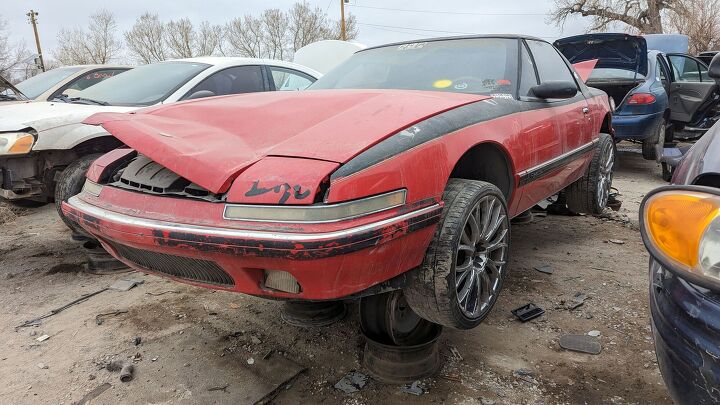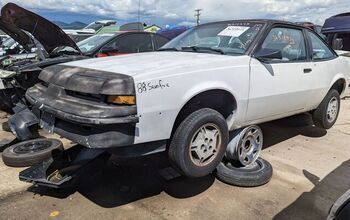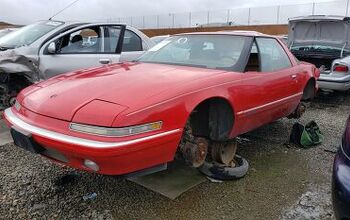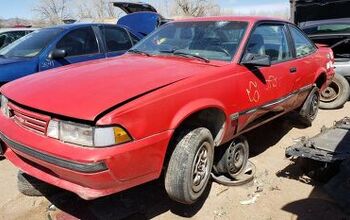Junkyard Find: 1988 Buick Reatta Coupe

Just over 20,000 Buick Reattas were made during the model's production run for the 1988 through 1991 model years, and I had documented seven of them in car graveyards prior to today's Junkyard Find. All of those cars were in reasonably good condition, but today's '88 is an example of a Reatta that was loved to death by its final owner.
A 1970s desire on the part of Cadillac dealers for a two-seater to compete with the Mercedes-Benz R107 plus fierce intra-GM political battles led to the development of a couple of interesting two-seat designs that hit American roads during the late 1980s. One was the Cadillac Allanté, while the other was the Buick Reatta.
Both the Allanté and the Reatta rode on modified versions of the front-wheel-drive Cadillac Eldorado/ Oldsmobile Toronado/ Buick Riviera chassis, so they weren't exactly direct competitors for sporty European machinery.
The Reatta's engine was the good old 3.8-liter pushrod Buick V6, which was quite dependable but not so sporty. This one offered 165 horses (which made a sound more bovine than equine).
The only Reatta transmission available was a four-speed automatic.
One futuristic Reatta feature the European competition ( mostly) couldn't match was Buick's Electronic Control Center, which featured a touchscreen computer display (sourced from an ATM manufacturer) decades before such screens became commonplace in vehicles.
The ECC and digital dash have been pulled from this car, though it's likely that they weren't in working order.
It endured some rough handling during its final years. Someone appears to have spray-painted the seats flat black, for starters.
The hood has been pried open, but we can blame that on time-pressed junkyard employees who had to drain the fluids right now.
Same goes for the mangled decklid.
This car started out red, but got a rattle-can/Plasti-Dip two-tone paint job late in life.
The multi-bolt-pattern aftermarket wheels aren't what the Reatta's designers had in mind.
These wheels are a bit scraper-ish, but that's an East Bay style and this car is in a yard just outside Denver.
Perhaps the final owner of this car was inspired by East Bay native Kreayshawn's 1990 Buick Reatta when it came to customizing touches. Like Jim Morrison, Mrs. Fields, and myself, Kreayshawn attended Alameda High School on the Island that Rust Forgot.
Even though California now has legal cannabis, those West Coast lightweights are far behind Colorado when it comes to slapping cannabis-themed stickers in and on their cars. This Reatta has such stickers inside the engine compartment.
There's an oil pressure gauge under the hood as well. If you must run a mechanical oil pressure gauge (feel free to write a 20,000-word rant on the subject in your comments), this is a good place to put it… if you don't like hot motor oil spraying all over your legs while you're driving.
This car's sticker collection is interesting, culturally speaking, so I'll share some more detail photos. First, the de rigueur "Hellastock" decal on the rear glass.
I've seen dispensary stickers slapped over gauge clusters and on the windshield directly before the driver's face. This one appears to have fallen off from the headliner.
If you say so.
This one is something of a flashback to 1980s-style misogyny.
Here's one that goes back to the 1970s.
It is indeed.
I believe it.
Nothing like issuing a challenge to your neighbors.
Skeletal hand with rose decal? Check.
This Buick Club of America sticker seems older than the others.
If your aim in life has always been high, drive the premium two-seater from Buick.
This ad made it seem that Buick was ashamed of the 1947 Special.
[Images: The Author]
Become a TTAC insider. Get the latest news, features, TTAC takes, and everything else that gets to the truth about cars first by subscribing to our newsletter.

Murilee Martin is the pen name of Phil Greden, a writer who has lived in Minnesota, California, Georgia and (now) Colorado. He has toiled at copywriting, technical writing, junkmail writing, fiction writing and now automotive writing. He has owned many terrible vehicles and some good ones. He spends a great deal of time in self-service junkyards. These days, he writes for publications including Autoweek, Autoblog, Hagerty, The Truth About Cars and Capital One.
More by Murilee Martin
Latest Car Reviews
Read moreLatest Product Reviews
Read moreRecent Comments
- Jalop1991 In a manner similar to PHEV being the correct answer, I declare RPVs to be the correct answer here.We're doing it with certain aircraft; why not with cars on the ground, using hardware and tools like Telsa's "FSD" or GM's "SuperCruise" as the base?Take the local Uber driver out of the car, and put him in a professional centralized environment from where he drives me around. The system and the individual car can have awareness as well as gates, but he's responsible for the driving.Put the tech into my car, and let me buy it as needed. I need someone else to drive me home; hit the button and voila, I've hired a driver for the moment. I don't want to drive 11 hours to my vacation spot; hire the remote pilot for that. When I get there, I have my car and he's still at his normal location, piloting cars for other people.The system would allow for driver rest period, like what's required for truckers, so I might end up with multiple people driving me to the coast. I don't care. And they don't have to be physically with me, therefore they can be way cheaper.Charge taxi-type per-mile rates. For long drives, offer per-trip rates. Offer subscriptions, including miles/hours. Whatever.(And for grins, dress the remote pilots all as Johnnie.)Start this out with big rigs. Take the trucker away from the long haul driving, and let him be there for emergencies and the short haul parts of the trip.And in a manner similar to PHEVs being discredited, I fully expect to be razzed for this brilliant idea (not unlike how Alan Kay wasn't recognized until many many years later for his Dynabook vision).
- B-BodyBuick84 Not afraid of AV's as I highly doubt they will ever be %100 viable for our roads. Stop-and-go downtown city or rush hour highway traffic? I can see that, but otherwise there's simply too many variables. Bad weather conditions, faded road lines or markings, reflective surfaces with glare, etc. There's also the issue of cultural norms. About a decade ago there was actually an online test called 'The Morality Machine' one could do online where you were in control of an AV and choose what action to take when a crash was inevitable. I think something like 2.5 million people across the world participated? For example, do you hit and most likely kill the elderly couple strolling across the crosswalk or crash the vehicle into a cement barrier and almost certainly cause the death of the vehicle occupants? What if it's a parent and child? In N. America 98% of people choose to hit the elderly couple and save themselves while in Asia, the exact opposite happened where 98% choose to hit the parent and child. Why? Cultural differences. Asia puts a lot of emphasis on respecting their elderly while N. America has a culture of 'save/ protect the children'. Are these AV's going to respect that culture? Is a VW Jetta or Buick Envision AV going to have different programming depending on whether it's sold in Canada or Taiwan? how's that going to effect legislation and legal battles when a crash inevitibly does happen? These are the true barriers to mass AV adoption, and in the 10 years since that test came out, there has been zero answers or progress on this matter. So no, I'm not afraid of AV's simply because with the exception of a few specific situations, most avenues are going to prove to be a dead-end for automakers.
- Mike Bradley Autonomous cars were developed in Silicon Valley. For new products there, the standard business plan is to put a barely-functioning product on the market right away and wait for the early-adopter customers to find the flaws. That's exactly what's happened. Detroit's plan is pretty much the opposite, but Detroit isn't developing this product. That's why dealers, for instance, haven't been trained in the cars.
- Dartman https://apnews.com/article/artificial-intelligence-fighter-jets-air-force-6a1100c96a73ca9b7f41cbd6a2753fdaAutonomous/Ai is here now. The question is implementation and acceptance.
- FreedMike If Dodge were smart - and I don't think they are - they'd spend their money refreshing and reworking the Durango (which I think is entering model year 3,221), versus going down the same "stuff 'em full of motor and give 'em cool new paint options" path. That's the approach they used with the Charger and Challenger, and both those models are dead. The Durango is still a strong product in a strong market; why not keep it fresher?


























































Comments
Join the conversation
Remember, tone deaf offerings like this had zero to do with GM declaring not bankruptcy. I actually like this, but I like it as a cheap used car that is something different. On what planet were this and the Alante seen as being good ideas
My 1988 Reatta has 92k on it. I purchased it from the original owner, had to address the CRT issues w/many investigations & not many options. Finally, a successful analysis & repair. Still Runs Like New, minus the radio/sound issues, BUT, A blessing to own cuz American 'ol Skool RULES!!!